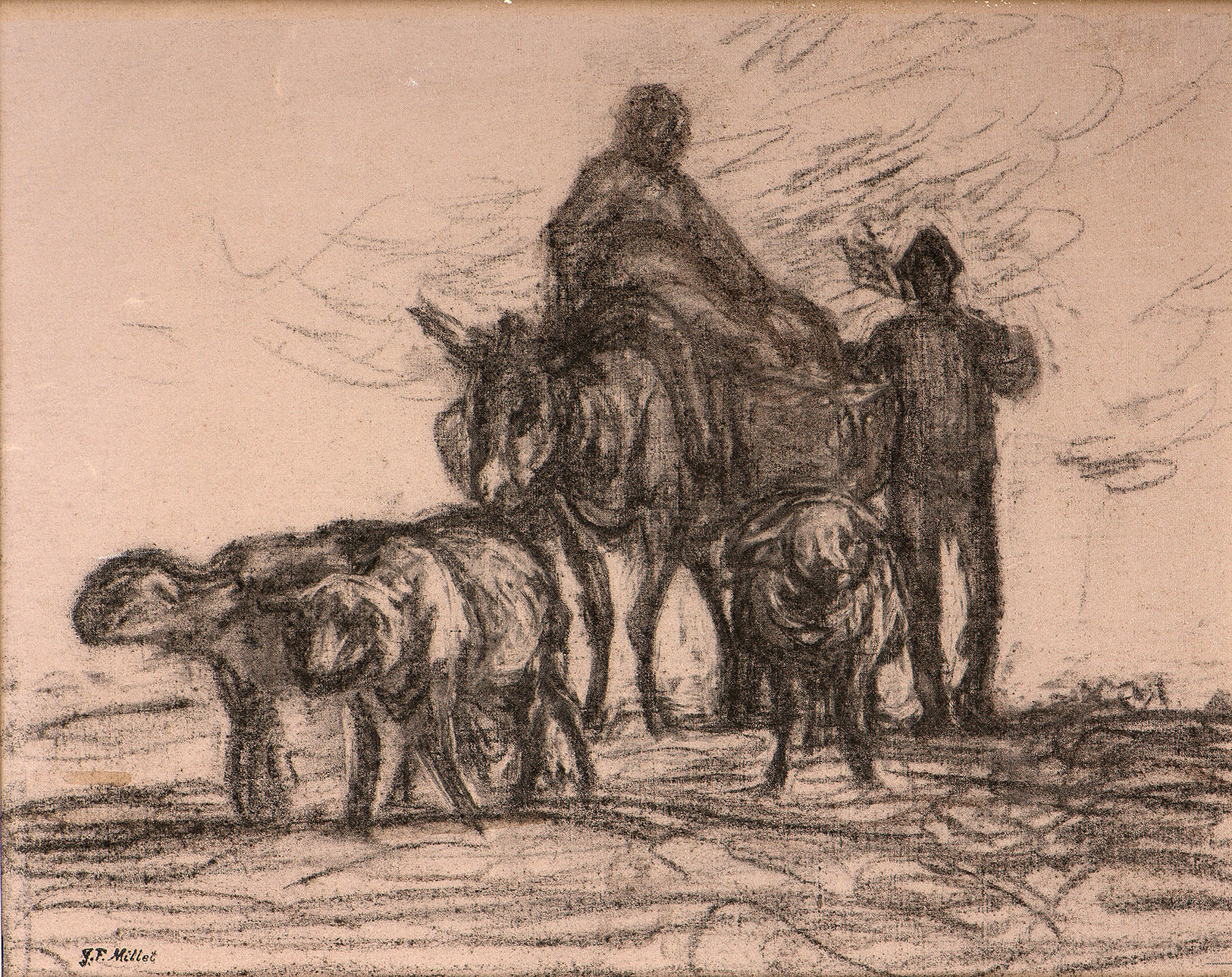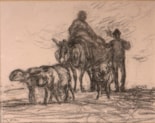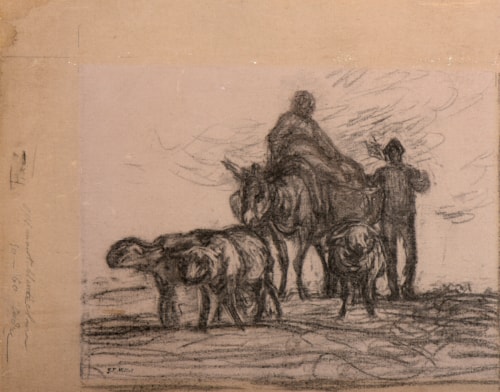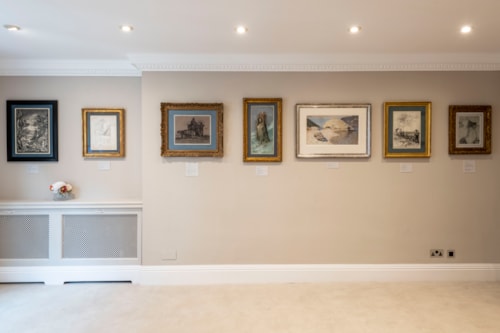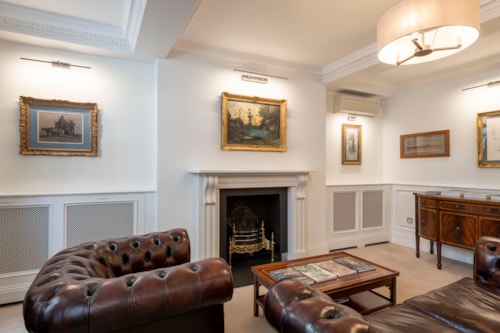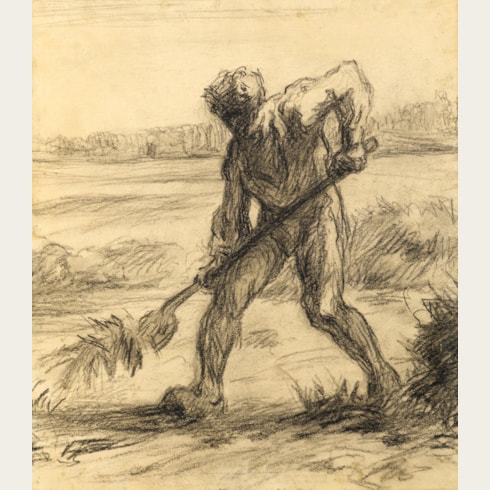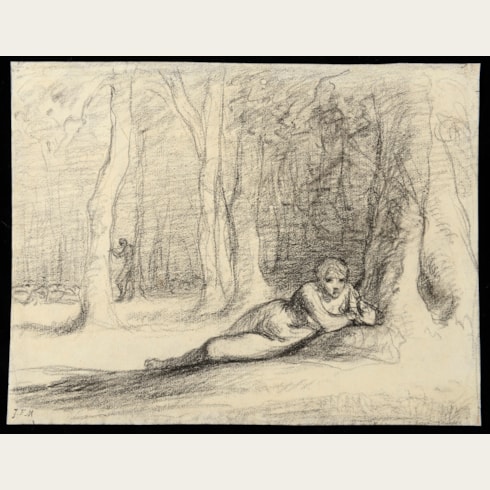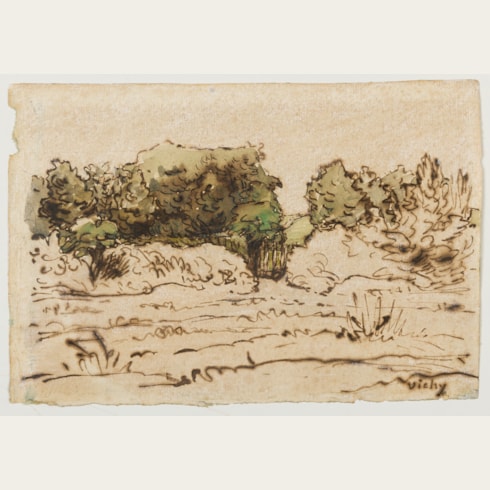Jean-François MILLET
(Gruchy 1814 - Barbizon 1875)
The Return from the Fields (The Evening Star)
Charcoal on canvas.
295 x 369 mm. (11 5/8 x 14 1/2 in.) [image]
353 x 437 mm. (13 7/8 x 17 1/4 in.) [canvas]
295 x 369 mm. (11 5/8 x 14 1/2 in.) [image]
353 x 437 mm. (13 7/8 x 17 1/4 in.) [canvas]
Many of Millet’s finest drawings are studies of peasant men and women at work. This was a world he knew well, and one that he was born into. As a young boy in the small village of Gruchy in Normandy, Millet had worked alongside his father on his family’s farm - looking after the animals, tilling the soil, sowing and reaping – and remained proud of these experiences throughout his later life as an artist. Millet remained deeply attached to the idea of the French countryside, and to the people who lived and worked there, and strove to accurately and sympathetically represent their daily lives in the paintings he sent to the annual Salons. As Herbert has written, ‘[Millet’s] view of the peasant was a conservative one. He was convinced that man is condemned forever to bear his burdens, hence he made the peasant into a victim of unyielding fate that kept him in the unchanging cycle of work and exhausted repose, the cycle that has been his lot since ancient times.’ But at the same time Millet’s peasant figures are often imbued with a sense of dignity, and at times even of grandeur; as Herbert points out, ‘His work joined in a complex process that resulted in the elevation of common man to the rank of history painting.’
With a composition consciously reminiscent of the Biblical subject of the Flight into Egypt, this charcoal drawing exemplifies Millet’s approach towards expressing the dignity of peasant life by associating it with the vocabulary of religious art, thereby combining the spiritual and the secular. Crossing a barren plain and outlined against the sky, a family returns home with three sheep at the end of the day. The woman rides on a donkey with her feet in a basket, while a man follows behind, holding a fork. Millet spent many early evening hours on the plain of Chailly, on the edge of Barbizon, and he once said that ‘It is astonishing towards the approach of night how grand everything on the plain appears, especially when we see figures silhouetted against the sky. They look like giants.’ Datable to c.1873, this charcoal sketch on canvas is a preparatory study for a painting of that year entitled The Return from the Fields (The Evening Star), which appeared at auction in 1991. One of Millet’s last great paintings, The Return from the Fields is the final treatment of a subject to which he had returned repeatedly throughout his career. Included in the artist’s studio sale in 1875, the painting was purchased at the auction for 6,050 francs by the collector Jean Dollfus, who also later owned both the present sheet and another compositional sketch for the same picture, now untraced. A study for the donkey is last recorded with the art dealer Hector Brame in Paris in 1938. Millet had earlier treated a similar subject and composition in a finished conté crayon and pastel drawing entitled Twilight (Crépuscule), drawn between 1859 and 1863 and today in the Museum of Fine Arts in Boston.
The present work is one of a small group of sketches by Millet which are drawn directly in charcoal on a lilac-coloured, prepared canvas, and are studies for late paintings by the artist. A stylistically comparable work of a similar subject and date, also drawn in charcoal on canvas, appeared at auction in 1988 and 2015, and is a study for a lost painting of The Return of the Shepherdess of 1874. Also part of this group is a sketch of a Winnower at Rest, recently on the art market in New York, which is a study for a painting left unfinished at the artist’s death in 1875, and a Temptation of Saint Anthony in the Albertina in Vienna.
The first owner of this late drawing was the prominent Alsacian industrialist and collector Jean Dollfus (1823-1911). Dollfus owned numerous paintings and drawings by Corot, as well as works by Courbet, Daumier, Delacroix, Rousseau, Renoir, Sisley and many others. At the posthumous sale of Dollfus’s collection in Paris in 1912, this drawing and the large painting for which it is a study were both acquired by the Knoedler gallery in New York and almost immediately sold by them to the collector Robert Paterson of Massachusetts.
The J.F. Millet stamp at the lower left of the sheet was applied to the unsigned works dispersed at the sale of the collection of the artist’s widow in April 1894.
With a composition consciously reminiscent of the Biblical subject of the Flight into Egypt, this charcoal drawing exemplifies Millet’s approach towards expressing the dignity of peasant life by associating it with the vocabulary of religious art, thereby combining the spiritual and the secular. Crossing a barren plain and outlined against the sky, a family returns home with three sheep at the end of the day. The woman rides on a donkey with her feet in a basket, while a man follows behind, holding a fork. Millet spent many early evening hours on the plain of Chailly, on the edge of Barbizon, and he once said that ‘It is astonishing towards the approach of night how grand everything on the plain appears, especially when we see figures silhouetted against the sky. They look like giants.’ Datable to c.1873, this charcoal sketch on canvas is a preparatory study for a painting of that year entitled The Return from the Fields (The Evening Star), which appeared at auction in 1991. One of Millet’s last great paintings, The Return from the Fields is the final treatment of a subject to which he had returned repeatedly throughout his career. Included in the artist’s studio sale in 1875, the painting was purchased at the auction for 6,050 francs by the collector Jean Dollfus, who also later owned both the present sheet and another compositional sketch for the same picture, now untraced. A study for the donkey is last recorded with the art dealer Hector Brame in Paris in 1938. Millet had earlier treated a similar subject and composition in a finished conté crayon and pastel drawing entitled Twilight (Crépuscule), drawn between 1859 and 1863 and today in the Museum of Fine Arts in Boston.
The present work is one of a small group of sketches by Millet which are drawn directly in charcoal on a lilac-coloured, prepared canvas, and are studies for late paintings by the artist. A stylistically comparable work of a similar subject and date, also drawn in charcoal on canvas, appeared at auction in 1988 and 2015, and is a study for a lost painting of The Return of the Shepherdess of 1874. Also part of this group is a sketch of a Winnower at Rest, recently on the art market in New York, which is a study for a painting left unfinished at the artist’s death in 1875, and a Temptation of Saint Anthony in the Albertina in Vienna.
The first owner of this late drawing was the prominent Alsacian industrialist and collector Jean Dollfus (1823-1911). Dollfus owned numerous paintings and drawings by Corot, as well as works by Courbet, Daumier, Delacroix, Rousseau, Renoir, Sisley and many others. At the posthumous sale of Dollfus’s collection in Paris in 1912, this drawing and the large painting for which it is a study were both acquired by the Knoedler gallery in New York and almost immediately sold by them to the collector Robert Paterson of Massachusetts.
The J.F. Millet stamp at the lower left of the sheet was applied to the unsigned works dispersed at the sale of the collection of the artist’s widow in April 1894.
One of the founders of the Barbizon school of painting in France, Jean-François Millet studied at the Ecole des Beaux-Arts in Paris. It was in Paris in the 1840’s that Millet became associated with a group of landscape painters who were to become part of the Barbizon circle, including Théodore Rousseau, Constant Troyon, Narcisse Diaz de la Peña and Charles Jacque. Although Millet’s early career was dominated by portraits, by the 1850’s he began to paint pastoral subjects, many of which were acquired by his first patron and future biographer Alfred Sensier. Millet established his public reputation as a painter of peasant life with three seminal paintings; The Sower, exhibited in 1850, The Gleaners, painted in 1857, and The Angelus, completed in 1859. By the 1860’s Millet enjoyed a very successful career, receiving many commissions for paintings and, from the Parisian architect and collector Emile Gavet, for a series of highly finished pastel drawings. Honoured with an exhibition of his work at the Exposition Universelle in 1867, Millet was elected to the jury of the Salon in 1870, but by this time was already beginning to suffer from poor health. Four months after the artist’s death in January 1875, the contents of his studio were dispersed at auction.
Millet was a skilled draughtsman, whose work ranged from quick sketches and more elaborate figure studies, to landscape studies in pen and watercolour, to highly finished pastel drawings that were sold as autonomous works of art, often for considerable sums of money. Robert Herbert has noted that ‘Millet’s penchant for drawing was catered to by the nature of his market. In the early years at Barbizon he sold few paintings at all, and at such derisory prices that the sale of three or four drawings could produce the same income…As the decade progressed – especially after the relative success of his Salon of 1853 – Millet acquired more opportunities for selling oils. Drawings still held priority, however, for they were his instinctive way of creating. Almost all his paintings were chosen from among drawings that had already been completed.’1 In the last decade of his career, landscape began to assume a more important role in his art, inspired in part by his travels beyond Barbizon. Although Millet lived in Barbizon from 1849 till the end of his career, he often spent summers elsewhere, such as his native Normandy and the Auvergne.
Provenance
The widow of the artist, Catherine Lemaire, Mme. J.-F. Millet (Lugt 1815)
Her estate sale, Paris, Hôtel Drouot, 24-25 April 1894, lot 25 (‘Le Départ pour le marché. Dessin au fusain. Haut., 28 cent.; larg., 26 cent.’)
Jean Dollfus, Paris
His posthumous sale, Paris, Hôtel Drouot, 4 March 1912, lot 83 (‘Le Retour des champs (l’Etoile du soir)’
Knoedler & Co., New York
Acquired from them in 1912 by Robert W. Paterson, Lenox, Massachusetts
By descent to his wife, Marie Louise Paterson, New York
Her estate sale, New York, Parke-Bernet Galleries, 17 March 1938, lot 8
James Kirkman, London, in 1984
Galerie Prejger, Paris
Bought from them in April 1984 by Jan Krugier and Marie-Anne Poniatowski, Geneva.
Her estate sale, Paris, Hôtel Drouot, 24-25 April 1894, lot 25 (‘Le Départ pour le marché. Dessin au fusain. Haut., 28 cent.; larg., 26 cent.’)
Jean Dollfus, Paris
His posthumous sale, Paris, Hôtel Drouot, 4 March 1912, lot 83 (‘Le Retour des champs (l’Etoile du soir)’
Knoedler & Co., New York
Acquired from them in 1912 by Robert W. Paterson, Lenox, Massachusetts
By descent to his wife, Marie Louise Paterson, New York
Her estate sale, New York, Parke-Bernet Galleries, 17 March 1938, lot 8
James Kirkman, London, in 1984
Galerie Prejger, Paris
Bought from them in April 1984 by Jan Krugier and Marie-Anne Poniatowski, Geneva.
Literature
New York, Christie’s, 19th Century European Paintings, Drawings, Watercolors and Sculpture, 16 October 1991, p.76, under lot 88; Alexander Dückers, ed., Linie, Licht und Schatten: Meisterzeichnungen und Skulpturen der Sammlung Jan und Marie-Anne Krugier-Poniatowski, exhibition catalogue, Berlin, 1999, illustrated p.411; Philip Rylands, ed., The Timeless Eye: Master Drawings from the Jan and Marie-Anne Krugier-Poniatowski Collection, exhibition catalogue, Venice, 1999, illustrated p.411.

